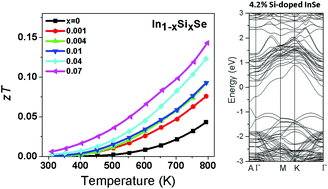Enhanced thermoelectric transport properties of n-type InSe due to the emergence of the flat band by Si doping†
Abstract
Post-transition-metal chalcogenides, such as SnSe, SnSe2, In4Se3, and In2Se3, have attracted renewed attention as promising thermoelectric materials mainly due to their inherent low lattice thermal conductivities, originating from the atomically layered structure. Herein, we demonstrate the enhanced thermoelectric transport properties of n-type InSe in an effort to search for new thermoelectric materials within post-transition-metal chalcogenide systems. By Si doping at the In site, significantly enhanced electrical conductivity is obtained, mainly due to the simultaneous increase in both carrier concentration and mobility. Meanwhile, the large Seebeck coefficient is maintained despite the increase of carrrier concentration with Si doping. Based on theoretical considerations for band structure change by Si doping, this unconventional trade-off between electrical conductivity and Seebeck coefficient is due to the generation of heavy flat energy levels near the conduction band minimum in the presence of Si at the In site. The doped Si also acts as an effective point defect phonon scattering center, resulting in reduced lattice thermal conductivity. Due to this synergetic effect, a 210% improved thermoelectric figure of merit (zT) of 0.14 at 795 K compared with pristine InSe was obtained by 7% Si doping.



 Please wait while we load your content...
Please wait while we load your content...